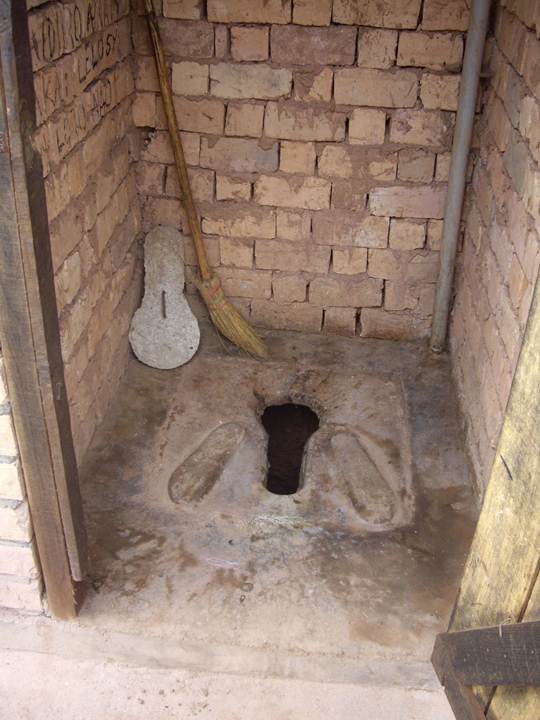 In October last year, Dr Alison Parker (Cranfield University) gave a brilliant talk at the GfGD conference – discussing the role of geologists in providing access to clean water and safe sanitation. The importance of the latter half of this duet of basic needs came as a surprise to many. In this guest blog, our first of 2014, Alison writes in more detail about geology, sanitation and supporting community development…
In October last year, Dr Alison Parker (Cranfield University) gave a brilliant talk at the GfGD conference – discussing the role of geologists in providing access to clean water and safe sanitation. The importance of the latter half of this duet of basic needs came as a surprise to many. In this guest blog, our first of 2014, Alison writes in more detail about geology, sanitation and supporting community development…
The link between water supply and geology is relatively obvious. With 96% of the unfrozen freshwater on earth being groundwater it’s clear that hydrogeologists have a vital role to play in locating water supplies. But what about protecting groundwater? Of course there are numerous sources of groundwater contamination including agriculture and industry. But in rural areas of developing countries one of the main concerns is unlined latrines.
Unlined latrines are the simplest form of improved sanitation. A pit is dug and covered with a latrine slab. A superstructure is built using local construction techniques. The liquid portion of the waste leaches into the ground whilst the solid portion remains in the pit. The latrine fills slowly and many years may pass before it is full. Then the pit is covered, and the slab and superstructure are moved to a freshly dug pit to start the process over again. A tree can even be planted on the location of the old pit to make use of all those nutrients (this is called an arborloo).
But all that leached liquid contains pathogens that pose a risk to health. And this is where the hydrogeologist steps back in. In many scenarios the leaching water presents barely any risk to groundwater supplies. The unsaturated zone provides many mechanisms to slow down the transport of pathogens. Some are physically filtered out. Some adsorb to soil particles. Some will starve or be eaten by other naturally occurring organisms. Simple, unlined pit latrines are an affordable sanitation solution and reduce the incidences of open defecation.
However, there are some scenarios where they are not a good idea. If the groundwater is shallow then the leachate passes through very little of the unsaturated zone. If groundwater sources are close to latrines then more pathogens will get into the water supplies. The BGS have published guidelines for the minimum distance between the bottom of the pit and the water table, and the latrine and the groundwater source. Of course, you should also take into account the geology, the groundwater flow direction and the rate of loading of the pit latrine (e.g. if washing water is also disposed of into the latrine then the pathogens will move faster through the unsaturated zone). Also if flooding is frequent then pit latrines may be a bad idea.
In these scenarios a sealed pit can be used, but these fill up quickly and need to be emptied. Emptying with a shovel into buckets is the most common scenario but presents significant health risks as well as stigma to workers. Large vacuum trucks can work well but only if the latrine is accessible by road. Alternative pit emptying techniques are being developed but none are being used widely yet.

Manual pit emptying in Durban, South Africa. These emptiers are fortunate to have been supplied with good PPE and hygiene facilities. Others are not so lucky. (Credit: Alison Parker).
Other sanitation options are being proposed, from ecological sanitation where the focus is on the agricultural reuse of waste to much higher technology options (such as those under the Bill and Melinda Gates Foundation “reinvent the toilet” programme).
Finding the right balance of technology, usability, health benefits and cost is a challenge!
The subsurface has a remarkable capacity to absorb the waste we throw into it. Yet this capacity is not infinite! Water supply and sanitation need to be considered together so communities can have both clean water supplies and adequate facilities for the disposal and faeces.
Dr Alison Parker has a PhD in hydrogeology and is a lecturer in International Water and Sanitation at Cranfield Water Science Institute. She is also the Course Director for a dedicated MSc Course in Community Water and Sanitation, also at Cranfield University.


Solomon
Your analysis is so true. i think it will be very good to also look at the effects of urbanisation, waste disposal and land use (especially wetlands) on groundwater quality in developing nations/countries.
Alison Parker
Yes, if there are hanging latrines over wetlands, or emptied pit waste is disposed of into wetlands then there could be contamination of both ground and surface water.